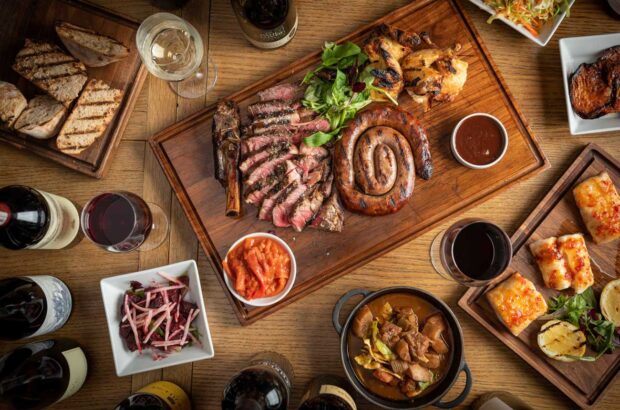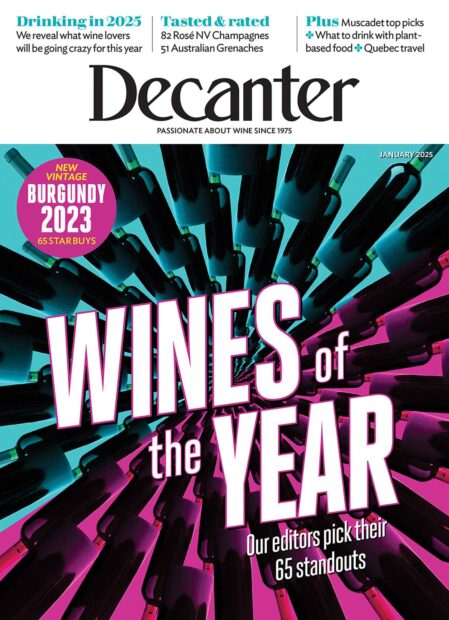We’re delighted people want to walk through our vineyards,’ beams Xavier Muller, vigneron and former mayor of Marlenheim, at the northern end of Alsace’s Route des Vins. 'It’s good for us – and it’s great for them!' The idea that anyone might want to discourage vineyard visitors is puzzling to this sprightly septuagenarian, who takes time out of his busy retirement schedule to escort people through the beautiful Steinklotz grand cru vineyard that rises steeply behind the village, giving distant, misty glimpses of Strasbourg cathedral.
We’re delighted people want to walk through our vineyards,’ beams Xavier Muller, vigneron and former mayor of Marlenheim, at the northern end of Alsace’s Route des Vins. ‘It’s good for us – and it’s great for them!’ The idea that anyone might want to discourage vineyard visitors is puzzling to this sprightly septuagenarian, who takes time out of his busy retirement schedule to escort people through the beautiful Steinklotz grand cru vineyard that rises steeply behind the village, giving distant, misty glimpses of Strasbourg cathedral.
The accessibility of Alsace’s vineyards is a major selling point. Here, instead of padlocked gates, scowling landowners or notices warning ‘entrée interdite’, you’re met by a network of beautifully laid-out and clearly signposted vineyard tracks just waiting to be walked.
Alsace is worth exploring at any time of the year – leading travel guide Lonely Planet singled out the region as one of its top 10 must-visit destinations for 2010 – but autumn is my favourite. The vineyards, alive with the buzz of grape pickers, tractors and trailers, burst into glorious shades of red, yellow and orange. Down in the villages, promising smells of newly fermenting must fight it out with insistent aromas of tarte à l’oignon, the new season’s choucroute and plump sweet plum tarts.
The difficulty lies in deciding which villages and vineyards to focus on. The Route des Vins stretches 170 kilometres from Thann in the south to Marlenheim in the north, and there are 47 wine trails (sentiers viticoles) to choose from. Clear a space on the kitchen table, spread out the panoramic map published by the CIVA (Alsace’s wine trade body; www.vinsalsace.com) and fix on a few strategic points on the route – one in the Haut-Rhin and another in the Bas-Rhin, with a sidestep to Strasbourg to finish. You’ll need a car to get there and to move around (and to stow your purchases), but once installed you can ditch your keys, set off on foot and enjoy getting up-close-and-personal with some world-famous vineyards.
Haut-Rhin
Riquewihr has lots going for it despite the crowds that frequently throng its narrow cobbled streets: great wine growers, good places to stay and eat, and a magnificent 15km grand cru trail which links up with five neighbouring villages and takes you through some of the Haut-Rhin’s most celebrated vineyards.
Take refuge in one of the suites that local chef and entrepreneur Jean-Luc Brendel has conjured out of the shell of a classic, beamed, 16th-century house on the main street – strategically placed opposite Hugel’s famous, wood-panelled tasting parlour. Or for a longer stay, consider renting Le Cottage, a luxury gîte tucked away on the edge of the village with its own garden and tiny pool.
From here you can pick up the wine trail, which goes right past the gate of Le Cottage. Keep your eyes peeled as you wander the back road from Riquewihr to Hunawihr. In one of the vineyards to your left you may spot some sheep grazing at the foot of the vines; closer inspection reveals small sandstone markers engraved with the name Clos Windsbuhl and the Zind-Humbrecht name and coat of arms. This is where the famous domaine’s Riesling, Gewurztraminer and Pinot Gris are born.
A little further on in the village of Hunawihr, spread out at the foot of the beautiful old church like a sort of apron, is the Clos-St-Hune vineyard, wholly owned by Trimbach and responsible for what is widely regarded not just as Alsace’s finest Riesling, but one of the world’s great white wines.
Set your sights now on Zellenberg, perched on its hill and a landmark for miles around. If the timing is right and stomachs are beginning to rumble, the cosy, low-ceilinged Auberge du Froehn does an excellent-value lunch menu. Or if picnicking is more your thing and the weather is on your side, follow the trail out of Zellenberg into the radiantly sunny Sonnenglanz grand cru vineyard, settle down with your provisions and savour the commanding views of the Rhine plain and Black Forest range etched on the eastern skyline.
Down in Beblenheim (which has almost as many superb, pastel-coloured, timber-framed houses as Riquewihr, and far fewer people) the trail takes you past the gate of Bott-Geyl, a spirited organic/biodynamic domaine that’s worth a visit. If you missed its vines in Sonnenglanz you can catch up with them the other side of the village in tiny Mandelberg, named after the almond trees (Mandeln) that flourish alongside the vines. From here you’re on the home stretch to Riquewihr, passing through the famous Sporen vineyard, birthplace of some of Hugel’s finest wines.
Pause at the entrance to Riquewihr at newcomer Domaine Agapé for a well-earned taste of Vincent Sipp’s expressive Pinot Blanc-Auxerrois blend, or his fruit-laden Helios Gewurztraminer, before retiring to your hotel. There’s plenty of choice for dinner but standouts are the trendy Brendelstub brasserie for meat and fish from the grill or wood-fired oven, and the cosy Sarment d’Or up the road for reliably good, genuine Alsatian.
Bas-Rhin to Strasbourg
Heading north into the Bas-Rhin, Andlau makes a good perch, with fine Renaissance houses, an imposing Romanesque abbey and three grand cru vineyards – Kastelberg, Wiebelsberg and Moenchberg – that have long been celebrated for their racy Rieslings. In between deepening your acquaintance with this great, undervalued, misunderstood grape, you can take off on the Circuit Piémont Viticole to nearby Barr or Mittelbergheim as the mood and weather dictate.
Stay a few nights at the Domaine des Marronniers in Guy and Marta Wach’s B&B, or at the Hotel Zinck next door. Either way you’ll have time for two leisurely tastings chez Wach: one entirely Riesling-focused, so you can compare the terroir effect of the different grand cru vineyards; and another devoted to Marronniers’ remaining grape varieties.
In the morning, set your sights on Barr, starting with a steepish climb to
the Kastelberg kiosque, a vantage point high above Andlau. It’s worth it for the bird’s-eye views of the rooftops, out over the surrounding vineyards to the plain of Alsace and – on clear days – across to Germany’s Black Forest. You get quite a different perspective walking through the orderly rows of vines of the Kastelberg and Wiebelsberg when the taste of the terroir is still with you from the night before. Once you’ve gained height from the village, the trail heads north towards the ruined Château du Haut-Andlau and eastwards in a leisurely loop to Barr at the foot of the Kirchberg grand cru.
A top dining tip in Barr is Au Potin, where Hervé Duhamel mixes classic brasserie dishes and bright new creations, with an intriguing selection of wines by the glass from wine-growing friends and neighbours (André Ostertag, Lucas Rieffel, Patrick Meyer et al). While in Barr, if you can squeeze past the tractors and trailers into the impossibly narrow, higgledy-piggledy courtyard of Domaine Hering (‘during the harvest it’s a bit rock ‘n roll here!’ smiles Fabienne Hering apologetically), you’ll be rewarded with a taste of its flowery Rosenegert. It’s made from four different varieties, co-planted and vinified together – Riesling for freshness, Gewurz for the floral notes, Pinot Gris to give weight and Muscat for what Fabienne calls ‘le croquant’ (a kind of crunchy character).
Next day you can strike out the other way, through the Moenchberg vineyard to Mittelbergheim, whose main street is lined with superb pink sandstone wine- grower houses. You’re assured of a warm welcome at Domaine André Rieffel – and a taste of the low-yielding, old-vine Pinot Blanc will sharpen the appetite for the Winstub Gilg’s famous feuilleté chaud du vigneron, a warm, flaky-crusted pork pie that brings tears of delight to the eyes of visiting wine importers. Ask anyone to point you in the direction of the Zotzenberg vineyard, famous for fine Sylvaner, from where you can wend your way back to Andlau.
Strasbourg
After viticulture and vineyard trails, the urban culture of Strasbourg beckons. Forget the motorway, and take the country road through the Couronne d’Or, a golden crown of vineyards west of the city, pausing for a final visit to Domaine Pfister in Dahlenheim, where Melanie Pfister makes award-winning Rieslings and a fragrant, glass-stoppered blend of four noble varieties called Cuvée 8 – she’s the eighth generation to make wine at the family domaine.
This approach from the west would deliver you almost to the door of the delicious Hotel-Restaurant Chut in Strasbourg’s Petite France quarter – except that driving anywhere in the medieval centre is a lost cause. Abandon the car in the Petite France car park (near the glass/granite Musée d’Art Moderne et Contemporain) and take instructions from the hotel staff, well used to ushering bewildered visitors to their door.
At this southwestern corner of the city, the river Ill opens up two arms that encircle and embrace the old town. This is the Grande-Ile, the medieval heart of the city, inscribed in its entirety on the UNESCO World Heritage list as a unique example of domestic Rhenish architecture. You can glide around the island inside a Bateau-Mouche excursion boat with headphones over your ears, but it’s a lot more fun to walk the quays that encircle the city at your own pace. That way you can marvel at the town houses that line the river bank, visit the tiny Musée Alsacien on the Quai St-Nicolas and stock up on take-home goodies at the Saturday morning farmer’s market on the Place du Marché aux Poissons.
After the press of people milling in and around the magnificent, single-spired, pink sandstone Gothic cathedral, it’s good to catch your breath and still your soul in the tiny medieval garden of the Musée de l’Oeuvre next door. And if you’ve time for one more church, it should be St-Pierre-le-Jeune at the top end of the island, for its fading frescoes and Romanesque cloister.
When you’ve pounded cobbled streets and overdosed on great museums, exuberant cathedral sculptures and intricately carved timber-framed houses, settle down at L’Atelier du Goût on the rue des Tonneliers. Here, Esther Morabito’s dazzling smile and pertinent wine advice together with her husband’s sunny cuisine will soon soothe any aches and pains. Sign off with dinner back at Chut, where the chef’s great little menu breaks resolutely with the über-touristy Petite France’s customary choucroute/tarte flambée model and sets off in its own deliciously quirky Mediterranean/Latin American/Asian direction.
Written by Sue Style






